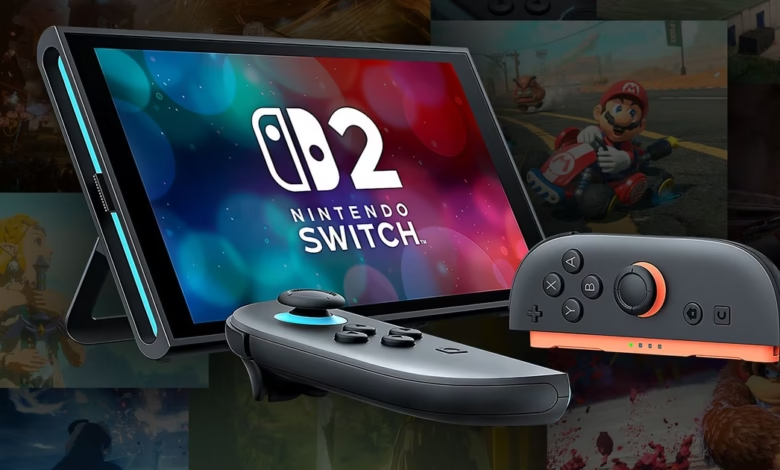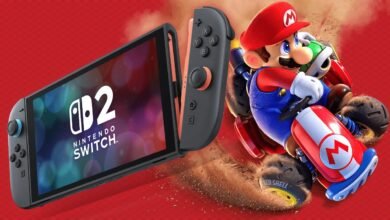Nintendo Switch 2 Hardware Review: Digital Foundry Breakdown

▼ Summary
– The Nintendo Switch 2 offers significant hardware upgrades, including a custom Nvidia processor and improved CPU/GPU performance, but falls short in display quality with a subpar LCD screen and poor HDR implementation.
– The system excels in power efficiency, consuming only 22W when docked and 10-12W in handheld mode, with battery life lasting at least 2 hours in demanding games.
– Switch 2 features enhanced WiFi and ethernet performance, delivering faster download speeds and including a built-in ethernet port, a notable improvement over the original Switch.
– Game Share and Game Chat are new features, with Game Chat being particularly impressive for its AI-powered voice isolation, while Game Share struggles with video quality and input lag.
– Despite its drawbacks, the Switch 2 is a solid generational upgrade, with strong third-party support and backward compatibility, though its screen and VRR functionality remain significant weaknesses.
The Nintendo Switch 2 marks a significant evolution in hybrid gaming, blending enhanced performance with the familiar versatility of its predecessor. Early impressions reveal a console that delivers meaningful upgrades while staying true to Nintendo’s core design philosophy—though not without some notable compromises.
Under the hood, the Switch 2 boasts a custom Nvidia T239 chip, leveraging Ampere architecture with 1,536 CUDA cores and support for ray tracing and DLSS. Built on a hybrid Samsung 8nm/10nm process, it may lag behind competitors in raw efficiency but still manages impressive power optimization. The eight-core ARM Cortex A78C CPU (six cores accessible to developers) operates at 998MHz docked and 1.1GHz in handheld mode, with a theoretical peak of 1.7GHz. Paired with 12GB of LPDDR5X memory, bandwidth reaches 102GB/s docked, a substantial leap over the original Switch.
Performance is where the Switch 2 truly shines. Docked gameplay caps at 22W power draw, while handheld mode sips just 8-10W, enabling 2.5 hours of playtime in demanding titles like No Man’s Sky. Efficiency is a standout achievement, though charging during intensive docked sessions proves sluggish. The larger LCD screen improves immersion, but HDR falls short with a peak brightness of 420 nits, failing to deliver true high dynamic range. Motion clarity also disappoints, exhibiting more blur than the 2017 Switch’s display.
VRR (Variable Refresh Rate) support is inconsistent. While the system technically supports a 40-120Hz window with low frame-rate compensation, real-world testing in Cyberpunk 2077 and Hitman: World of Assassination reveals noticeable judder below 40fps. Locked 30fps modes often provide a smoother experience.
Connectivity sees major upgrades. WiFi speeds jump to 363Mbps, a tenfold improvement over the Switch OLED, and the built-in Ethernet port (absent in older docks) delivers 720Mbps downloads. Load times are drastically reduced, Persona 4 Golden installs in 7 minutes vs. 32 on the original Switch.
New features like Game Share, allowing one Switch 2 to stream gameplay to another, show promise but suffer from poor video quality and input lag in fast-paced titles. Conversely, Game Chat, Nintendo’s Discord-like voice system, impresses with AI-powered noise suppression and seamless integration, though it occasionally strains CPU performance.
The redesigned Joy-Cons and Pro Controller refine ergonomics, with excellent button feedback and battery life. However, the Virtual Game Card system feels like a step backward, complicating library navigation.
Third-party and backward-compatible games benefit significantly, with many hitting stable 60fps or maxing dynamic resolution. Titles like Mario Kart World showcase Nintendo’s mastery, while upgrades for older games breathe new life into classics.
Despite its flaws, subpar HDR, inconsistent VRR, and a mediocre LCD, the Switch 2 excels as a refined, efficient hybrid console. It sets the stage for another generation of innovative gaming, even if some features don’t fully deliver on their promise. For players invested in Nintendo’s ecosystem, this is a compelling upgrade with room for future improvements.
(Source: Eurogamer)


